Gigabyte GeForce RTX 2070 Gaming OC 8G Review: Faster Than Nvidia's FE Alternative
Why you can trust Tom's Hardware
Power Consumption
Slowly but surely, we’re spinning up multiple Tom’s Hardware labs with Cybenetics’ Powenetics hardware/software solution for accurately measuring power consumption.
Powenetics, In Depth
For a closer look at our U.S. lab’s power consumption measurement platform, check out Powenetics: A Better Way To Measure Power Draw for CPUs, GPUs & Storage.
In brief, Powenetics utilizes Tinkerforge Master Bricks, to which Voltage/Current bricklets are attached. The bricklets are installed between the load and power supply, and they monitor consumption through each of the modified PSU’s auxiliary power connectors and through the PCIe slot by way of a PCIe riser. Custom software logs the readings, allowing us to dial in a sampling rate, pull that data into Excel, and very accurately chart everything from average power across a benchmark run to instantaneous spikes.
The software is set up to log the power consumption of graphics cards, storage devices, and CPUs. However, we’re only using the bricklets relevant to graphics card testing. Gigabyte's GeForce RTX 2070 Gaming OC 8G gets all of its power from the PCIe slot, one eight-pin PCIe connector, and a six-pin PCIe connector. Should higher-end 2080 Ti boards need three auxiliary power connectors, we can support that, too.

Idle

An average idle power measurement of 10.7W is almost 1W lower than what we observed in our GeForce RTX 2070 Founders Edition review. Gigabyte’s fans stop spinning at idle, so we’re undoubtedly seeing a bit of savings from this card’s 3D Active Fan feature.
Gaming
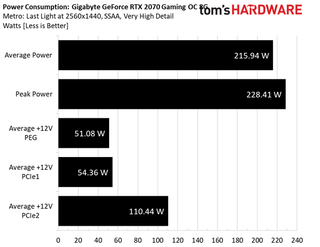
Our usual Metro: Last Light run at 1920 x 1080 isn’t taxing enough to push GeForce RTX 2070 to maximum utilization, so we increase the resolution to 2560 x 1440 and enable SSAA. Three loops through the benchmark are clearly delineated by power dips between them.

Most of the GeForce RTX 2070 Gaming OC 8G’s power comes from its eight-pin connector (PCIe2 12V Power in our chart). Add in the six-pin connector and PCIe slot, which are roughly equivalent, and you get 215.9W through our gaming workload.

AMD’s reference Radeon RX Vega 64 averages 277W through three runs of the Metro: Last Light benchmark, while GeForce GTX 1080 Founders Edition sees its power consumption pulled back before the first run ends, yielding a 162W average.
Meanwhile, the difference between GeForce RTX 2070 Gaming OC 8G and Nvidia’s Founders Edition card is illustrated by the red and blue lines. Gigabyte’s card has a notably higher power limit, right out of the box.

Gigabyte has no trouble keeping current draw from the PCIe slot well under the 5.5A limit.
FurMark
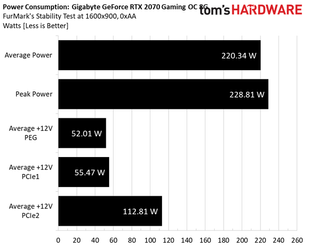
Maximum utilization yields a much more even line chart as we track ~10 minutes under FurMark.
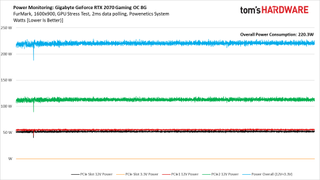
Gigabyte’s 2070 Gaming OC 8G maintains higher power consumption than the Founders Edition card, but lands way under AMD’s Radeon RX Vega 64.
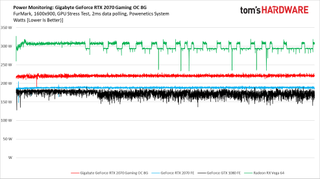
Current over the PCIe slot is perfectly acceptable.
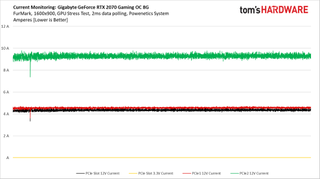
MORE: Best Graphics Cards
MORE: Desktop GPU Performance Hierarchy Table
MORE: All Graphics Content
Current page: Power Consumption
Prev Page Performance Results: 3840 x 2160 Next Page Temperatures and Fan SpeedsStay on the Cutting Edge
Join the experts who read Tom's Hardware for the inside track on enthusiast PC tech news — and have for over 25 years. We'll send breaking news and in-depth reviews of CPUs, GPUs, AI, maker hardware and more straight to your inbox.

